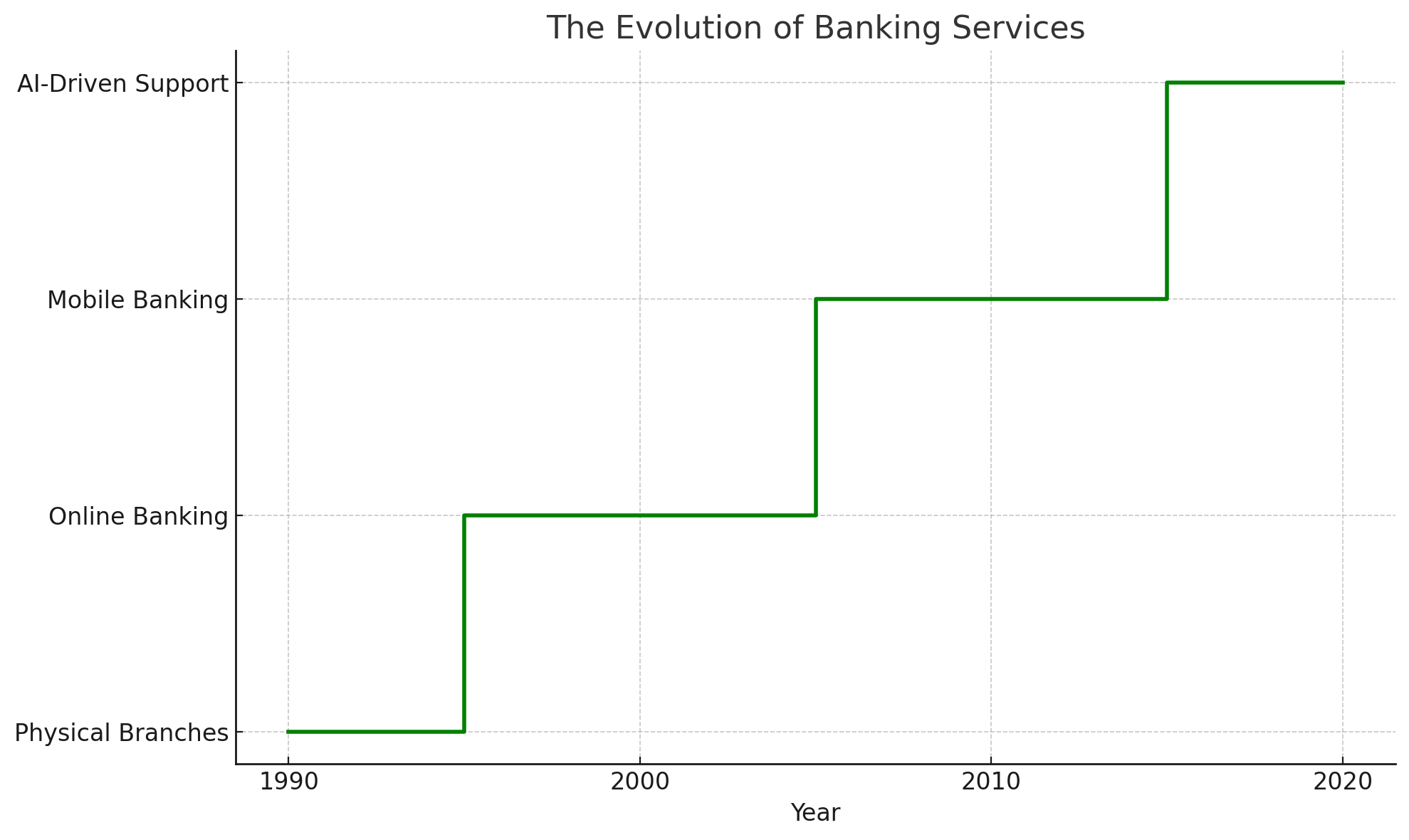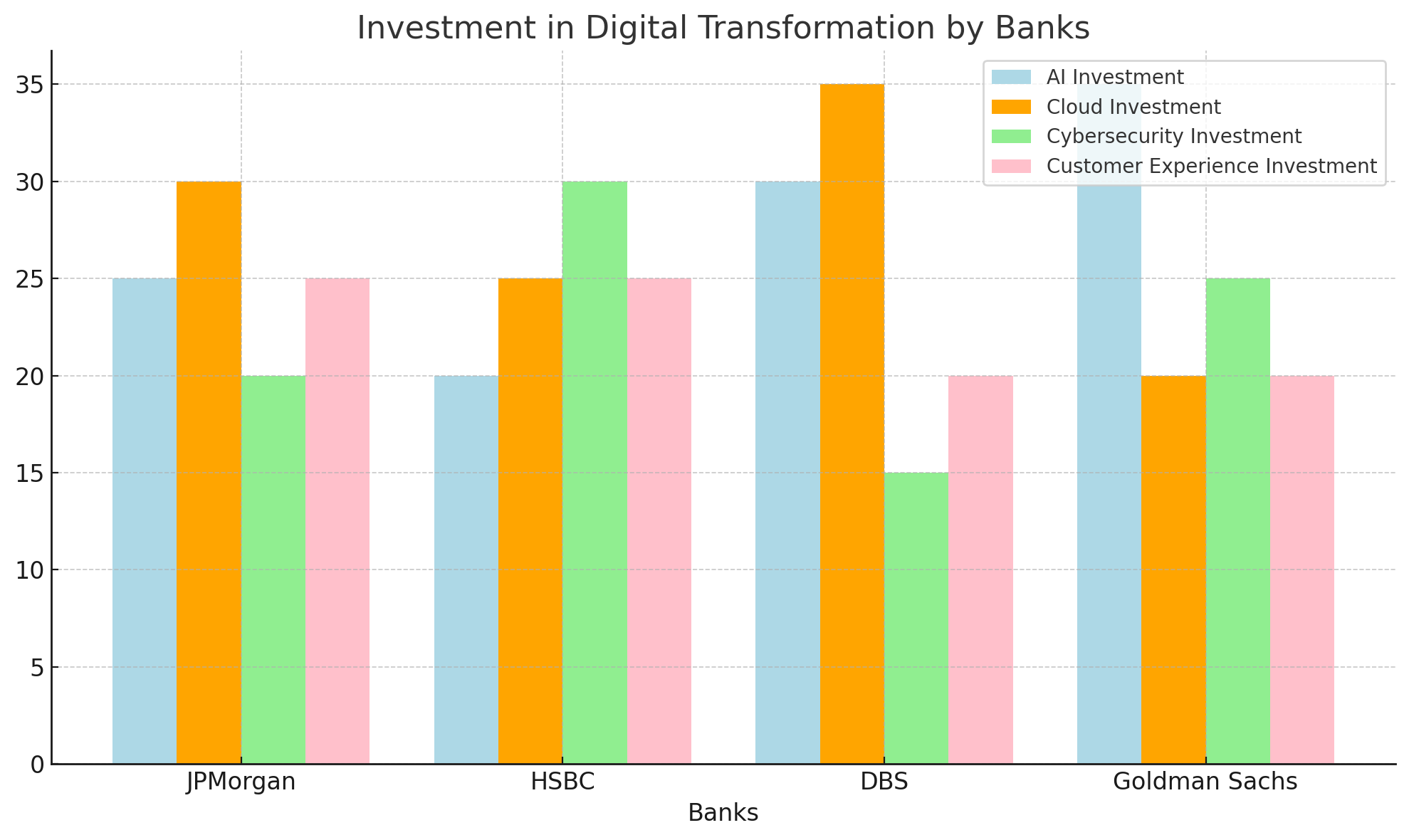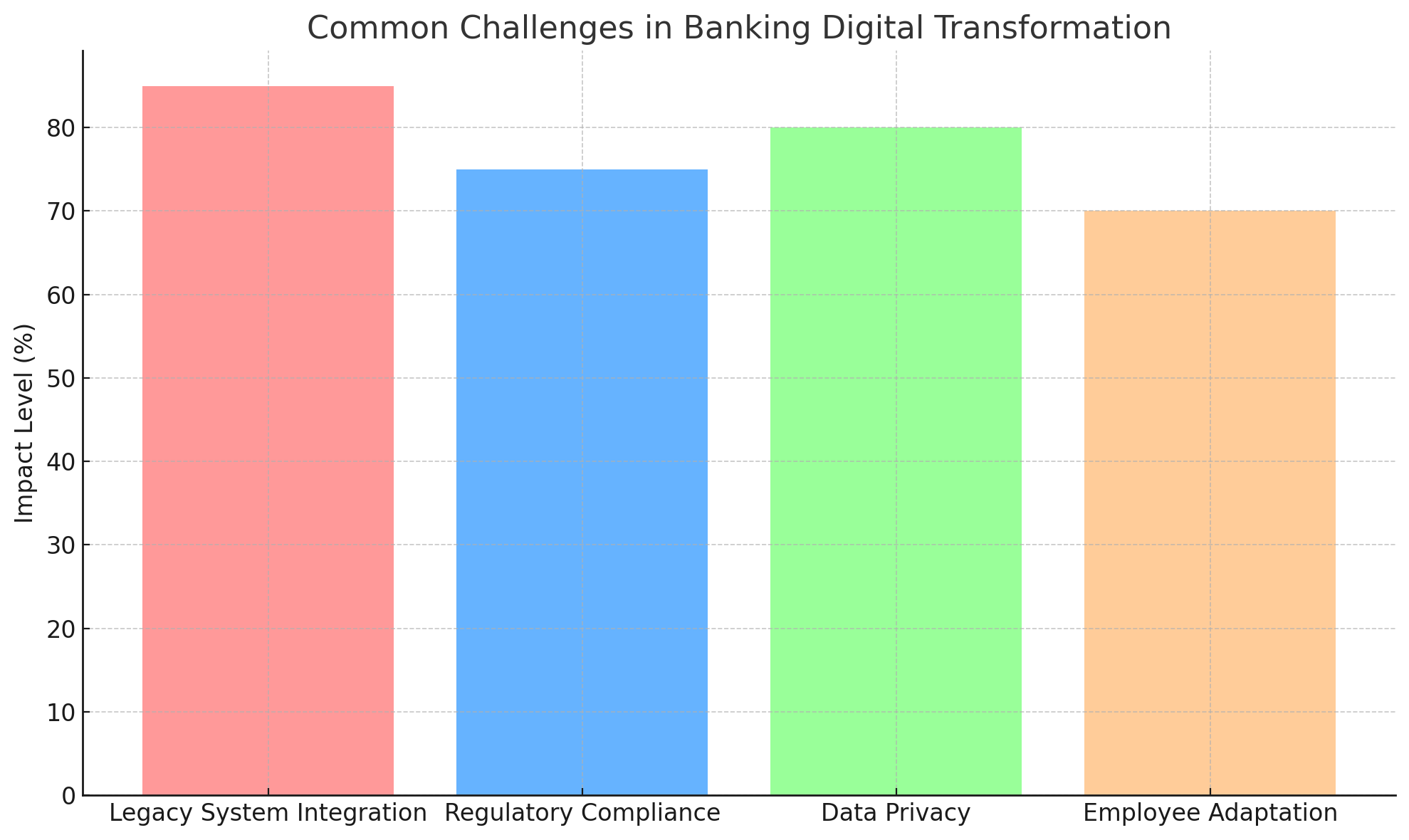“Simply put: keep money in banks, but don’t keep all your money in banks,” said our colleague from JPMorgan.
Nowadays, digital transformation is very important to meet customer needs. This change is more than just using new technologies. It is about how banks work, provide services, and interact with customers today.
Definition of Digital Transformation in Banking
Digital transformation in banking means using digital technologies to change how modern banks work and serve their customers. This pushes us to look at old banking methods, products, and services in a new way. The goal is to make banking better, focused on the customer, and driven by digital tools. This covers many areas, such as:
- Using new technologies like artificial intelligence, cloud computing, big data analytics, and blockchain. These feature help improve how banks operate, boost customer service, and create new financial products.
- Moving from thinking about products to thinking about customers. This involves using data and analytics to know what customers need and want, so banks can offer personalized financial solutions. Customer focus is one of the top trends of the 21st century.
- Building a smooth and connected customer experience across all digital channels. This includes online banking, mobile banking apps, and social media platforms.
Importance of Digital Transformation in the Financial Sector
Digital transformation is more than just updating technology. It is important for the future of the financial services sector. Here are a few reasons why:
- Better Customer Experience: Today’s customers want banking that is easy, personal, and digital. Digital transformation helps banks provide this with tools like mobile banking apps, AI chatbots, and tailored financial advice.
- More Efficient Operations: By automating tasks, improving workflows, and using data analytics, banks can work more efficiently and cut costs. This helps them use their resources better and focus on new ideas and services for customers.
- Edge over Competitors: The financial industry changes fast. Banks must adapt quickly to stay relevant. Digital transformation gives them an edge by helping them launch new products and services more quickly, react well to market changes, and attract customers who use technology.
The Evolution of Banking: From Traditional to Digital
Banking has changed a lot from its old way of building branches. Now, there is a big move from physical locations to digital platforms. This change is because of new technology and what customers want. Today’s digital banking offers convenience, easy access, and services that happen right away.

Tracing the Roots of Digital Transformation in Banking
The change in banking due to digital transformation took time. It slowly gained speed as the internet and mobile tech became common.
- At first, banks worked on making existing services digital, like online banking and mobile check deposits. This helped customers access their accounts more easily.
- As what customers wanted changed and new technologies appeared, banks saw they had to do more than just move old services online. They needed to rethink their whole ways of working and use digital technologies to create new services focused on the customer.
- This shift brought about mobile-first banking experiences, AI chatbots, and tools for personal finance management. These changes transformed the banking landscape and changed what customers expect.
The Catalysts for Change: Technological Advances and Consumer Expectations
Two main forces have driven the change in banking to go digital. These are fast technology growth and changing needs of today’s tech-smart customers.
- More people are using mobile devices. Cloud computing is growing quickly. Advances in artificial intelligence and big data analytics give banks the tools they need. This helps them rethink how they run their operations and serve their customers.
- At the same time, customers enjoy the easy, fast, and personalized services found in other digital platforms. They want their banks to offer the same level of service.
- Because of this mix of new technology and changing customer expectations, banks must embrace digital transformation. This change is now crucial for their success and survival in the banking industry.
The Role of Technology in Banking Evolution
Technology has changed banking a lot. It has helped move from old banking to digital platforms with new services. Here are some main ways technology has changed the banking industry:
- Online Banking and Mobile Apps: Online banking and mobile apps have changed how people access their accounts. They make it easy and convenient to manage money anytime, anywhere.
- Artificial Intelligence and Chatbots: AI chatbots are changing customer service. They provide quick help, answer questions, and solve problems anytime, day or night.
- Big Data Analytics: Banks are using big data to understand customer behavior. This helps them find trends, manage risks, and give better financial advice.
| Metric | Traditional Banking | Digital Banking |
| Customer Satisfaction | Moderate | High |
| Transaction Speed | Slower, dependent on branch hours | Instant |
| Cost Efficiency | Higher operational costs | Lower operational costs |
| 24/7 Access | Limited | Unlimited |
| Personalization | Low | High |
Unpacking Digital Transformation: Key Components and Strategies
A successful digital transformation process in banking depends on many different parts and plans that need to work together. This creates a banking experience that is fully digital. Banks should take a complete view of the situation. They need to focus on technology, customer experience, risk management, and their organization’s culture to handle this change well.
Defining Digital Transformation in the Banking Sector
In banking, digital transformation is a process that takes time and effort. It is not just an end goal. It means changing how we think, use technology, and organize our tasks.
- The focus is on using digital technologies to improve every part of the banking experience. This includes getting new customers, setting them up, developing products, delivering services, and managing risks.
- The goal is to provide a smooth and personalized customer journey that works well across all channels. It also involves making internal operations more efficient and agile. Finally, it encourages a culture of innovation and data-driven decisions.
- At its core, digital transformation seeks to build a banking system that is more focused on the customer, efficient, and competitive.
Strategic Pillars of Digital Transformation in Banking
Successfully going through the digital transformation journey in banking needs some important basic elements:
- Customer-Centricity: It is crucial to put the customer at the center of all transformation efforts. Banks should focus on understanding customer needs, expectations, and challenges. This helps in providing personalized experiences and building strong relationships.
- Data-Driven Decision-Making: In today’s world, data is very important. Banks should use data analytics to get useful insights from customer data, market trends, and their own operations. This will help them make informed decisions, improve processes, and reduce risks.
- Agile and Adaptable Operating Model: The banking industry is always changing. Banks must leave behind rigid, old-fashioned ways of working. Instead, they should choose more flexible and adaptable methods to quickly respond to market changes, customer needs, and new technologies.
Key Components:
Several important parts are needed for a successful digital transformation strategy in banking:
- Mobile Banking: Today, it’s essential to provide a smooth and full-featured mobile banking experience. Customers now want to do most, if not all, of their banking tasks easily from their smartphones.
- Data Analytics: Using data analytics is key to understanding customer behavior. It helps banks to personalize experiences, manage risks better, and find new opportunities.
- Cloud Computing: Cloud solutions give banks scale, flexibility, and lower costs. They help banks adjust quickly to changing needs and add new technologies easily.
In the following graphic you can see the importance of technology in digital banking:

Case Studies: How Top Banks Are Navigating Digital Transformation
Looking at how top banks are moving forward in their digital transformation journey gives important insights. It also shows best practices for other banks wanting to succeed in the digital age. These examples highlight new ways to improve customer experience, increase efficiency, and keep up with changes in the fast-paced financial world.
Case Study 1: JPMorgan Chase
JPMorgan Chase is a big player in investment banking. They are strongly pushing for digital transformation and spending a lot on technology and new ideas.
- The bank is putting money into data analytics and machine learning. This helps them manage risks better, find fraud more easily, and make customer experiences more personal.
- JPMorgan Chase is also working closely with clients. One key initiative is the Machine Learning Center of Excellence (MLCOE), which applies cutting-edge AI/ML methods to various banking functions, such as risk management and fraud prevention. The bank uses AI-powered chatbots and virtual assistants to enhance customer service, reduce operational costs, and improve client satisfaction.
- JPMorgan Chase has heavily invested in digital transformation, particularly focusing on AI and machine learning (ML). In 2023, the bank allocated $15.3 billion to technology investments, with a significant portion dedicated to AI and ML, leveraging its vast data resources to drive innovation. This includes managing over 500 petabytes of data across 300 use cases, from fraud detection to personalized customer services.
Despite its successes, JPMorgan continues to face challenges in AI deployment, especially with legacy systems and the need for highly skilled talent. Nevertheless, the bank is well-positioned to lead in AI-driven finance, setting the standard for other institutions

Case Study 2: DBS Bank
DBS Bank, based in Singapore, is a great example of how to do digital transformation well in banking. There are 3 main achievements in DBS Bank transofmation:
- DBS uses AI to send over 45 million hyper-personalized “nudges” to 5 million customers monthly, helping guide them toward better financial decisions, such as investment planning and risk management.
- Their AI tools, such as ADA and ALAN, allow rapid deployment of AI models for both consumer and business services. For instance, DBS Quick Finance enables SMEs to access loans in under a minute with almost instant approvals, supported by AI risk assessments.
- DBS has built a hybrid, multi-cloud infrastructure to enhance resilience and scalability, which has boosted their capacity to scale AI initiatives quickly. The bank has been able to reduce the time it takes to develop and deploy AI models from 18 months to just a few weeks
Case Study 3: HSBC
HSBC is one of the largest banks in the world. It has started a digital transformation program that will take several years. The goal is to improve its global operations and customer service.
- HSBC knows it needs to keep up with market trends and customer expectations. That is why it is investing in mobile banking, digital payments, and personalized financial advice.
- The bank is also working on making its internal processes more efficient. It is using data analytics and automation to save money and improve how it works.
- These digital transformation efforts show that HSBC is committed to staying competitive and relevant in today’s digital world.
While AI has transformed HSBC’s operational efficiency and customer services, the bank continues to navigate challenges related to maintaining personalization in a highly automated environment, ensuring ethical AI use, and improving the speed of AI deployments
Case Study 4: Goldman Sachs (Marcus)
The Marcus platform utilizes advanced technology like artificial intelligence (AI) and machine learning (ML) to personalize customer experiences. Through fintech acquisitions and partnerships, Marcus integrates AI-driven solutions that enhance personal finance management, including tools that analyze spending patterns, offer savings recommendations, and tailor loan options based on customer needs.
Notably, Marcus acquired Clarity Money, a financial management app that uses AI to help users manage their expenses more effectively.
Goldman Sachs also invests significantly in its cloud infrastructure, enabling more scalable and secure banking services. The bank emphasizes a platform approach to banking, building an API-driven architecture to unify customer experiences across different products. This digital-first approach aims to make Marcus a leader in consumer fintech, while leveraging the broader Goldman Sachs brand for trust and recognition.
Marcus’ rapid growth, driven by digital transformation, underscores Goldman Sachs’ ambition to position itself as a major player in consumer banking while maintaining its legacy as a top investment bank.
Now you can see how banks investing in Digital Transformation:

Lessons Learned from Case Studies
Leading banks teach us important lessons about change through digital transformation. As an example let’s take Goldman Sachs’ Marcus platform. This shows how using new technologies increases operational efficiency and boosts customer satisfaction. Key points include using data analytics and AI to improve customer experiences and better manage risks.
Successful digital changes highlight the need to be adaptable. Banks should focus on their customers and ensure strong security measures. These insights help banks adjust to the changing banking landscape, keep up with market trends, and provide new digital solutions that meet customer expectations.
Best Practices in Digital Transformation
Several good practices have come from the success of banks that managed digital transformation well. These tips can help other financial institutions start their own journeys:
- Invest in Good IT Infrastructure: A strong and modern IT setup is important. It helps support new technologies and manage the growing amount of data we see today.
- Focus on Customer Experience: Providing a smooth, personalized, and easy-to-use experience for customers across all digital channels is key to gaining and keeping customers in a tough market.
- Encourage Change Management: Digital transformation needs a change in mindset and workplace culture. Organizations should invest in training and communication to help employees adjust to new technologies, processes, and ways of working.
Common Challenges and How to Overcome Them
Navigating the digital transformation in banking comes with challenges. One big issue is mixing old legacy systems with new digital technologies. This can hurt operational efficiency and hinder potential cost savings.
Another challenge is customer data privacy and security measures, which need strong solutions to build trust. Also, keeping up with changing regulatory compliance standards while meeting customer expectations makes things more complicated.
To tackle these challenges, banks need a smart plan. This plan should use advanced technology solutions, change management, and focus on the customer. This way, they can ensure a successful digital transformation journey.
Here you can see impact level of challenges in Digital Banking:

Of course, transformation is a very complex and complex endeavor – there are examples of not-so-successful transformations as well, and you can read about them below.
| Bank | Outcome | Reason for Success/Failure |
|---|---|---|
| DBS Bank | Success | Strong customer focus, heavy investment in cloud and AI |
| HSBC | Partial Success | Issues with integrating legacy systems, regulatory delays |
| Wells Fargo | Failure | Outdated infrastructure, data breaches, lack of innovation |
| Deutsche Bank | Failure | Slow adoption of new technologies, internal resistance |
| Goldman Sachs (Marcus) | Success | Customer-first approach, strategic use of AI and analytics |
The Benefits of Embracing Digital Transformation for Banks and Their Customers
Digital transformation helps banks and their customers a lot. By using new technologies and methods, banks can provide better services. This change leads to great customer experiences. It also makes their work more efficient. Plus, it opens up new ways for growth and innovation.
Enhancing Customer Experience through Digital Channels
Digital transformation helps banks improve the customer experience. This makes banking easier, more personal, and accessible.
- Customers can use digital channels like online banking and mobile banking apps. They can manage their accounts, make transactions, and access financial services anytime and anywhere. This is a big change from traditional banking hours and locations.
- Banks can use customer data to understand what people need and prefer. This allows them to recommend products and provide financial advice that fits each person.
- By focusing on the customer, digital transformation increases customer satisfaction, builds loyalty, and creates long-term relationships.
Operational Efficiency and Cost Reduction: A Win-Win
Digital transformation helps banks work better and save money.
- Automating tasks like entering data, processing loans, and setting up accounts lets workers spend time on important projects.
- Cloud computing helps banks easily grow their IT needs. This cuts down the costs for machines and upkeep.
- By improving their internal processes and using new technology, banks can run smoothly, lower costs, and offer better rates and services to their customers.
Opening New Avenues for Revenue Generation
Digital transformation helps banks improve their current income and find new ways to grow and innovate.
- By using data analytics, banks can discover new customer groups, offer customized products, and create focused marketing efforts. This helps them reach more people and attract new customers.
- The online world encourages partnerships with fintech companies. This lets banks provide new and creative financial products and services.
- These offerings might include mobile payment options, peer-to-peer lending, and tailored investment advice. This can help banks create new income and increase their value to customers.
The Road Ahead: Predictions for the Future of Digital Banking
The world of digital banking is always changing. This change comes from new technology, what customers want, and strong competition. In the future, we can expect many exciting new things. Banks are using technology more and more to improve their services. They want to change the banking experience for their customers.
The Rise of Personalized Banking Services
The future of digital banking will focus on personalization. Banks will use artificial intelligence and machine learning to look at large amounts of customer data. This data will include spending habits, financial goals, and risk levels. With this information, they can provide highly personalized financial products and services.
- Imagine getting custom financial advice, special investment suggestions, and helpful alerts based on your personal financial situation and goals. All this would be delivered easily through your favorite digital channels.
- This kind of personalization is more than just calling customers by their names. It’s about really understanding their individual financial needs. Then, banks can provide the right help and support to help customers reach their financial goals.
Greater Integration of AI for Predictive Banking
Artificial intelligence will be more important in banking in the future. It will go beyond chatbots and fraud detection, enhancing customer support. We can expect predictive banking to grow. AI will look at past data, market trends, and customer behavior. It will do this to guess future needs and provide solutions before problems arise.
- For instance, your bank might use AI to see when you might struggle with cash flow. It could then offer you personalized loans or investment advice based on changes in the market.
- This approach will improve the customer experience. It will give you timely help and guidance so that you can make better financial choices.
The Expansion of Digital-only Banks and What It Means for Traditional Institutions
Digital-only banks are becoming more popular. They run completely online and do not have any physical branches. These banks use technology and new business models to provide lower fees, better interest rates, and a simpler online banking experience.
- The growth of digital-only banks brings both challenges and chances for traditional banks.
- To stay competitive, traditional banks need to change with the times. They should improve their digital services and find ways to stand out by focusing on customer service, personalized experiences, and unique financial products.
- The future of banking will depend on how well both traditional banks and digital-only banks can innovate and meet the changing needs of online customers.

Conclusion
Digital transformation in banking is more than just a trend. It is needed for banks to survive and grow. When we look at case studies from top banks like JPMorgan Chase, DBS Bank, HSBC, and Goldman Sachs, we can see how technology, what customers expect, and smart planning are really important in this change. The benefits are easy to see. Banks can offer better customer experiences, work more efficiently, and even find new ways to make money. In the future, we will see more personalized services, the use of AI, and digital-only banks. To keep up, traditional banks must make these changes and adapt to the digital age.
FAQ
What is meant by digital transformation in banking?
Digital transformation in banking means using new technologies to work better and change how customers feel about services. This change usually means using online and mobile banking. It also involves using data analytics to offer personalized services. Banks are adopting technologies like AI and cloud computing to help with this shift.
How are leading banks implementing digital transformation?
Leading banks are changing the way they work by focusing on customer data and how to run their services better. They are making easy-to-use mobile apps and using data analytics to give personalized insights. Banks also automating tasks to make everything work faster and to improve the banking experience for customers.
What technologies are pivotal for the digital transformation of banks?
The main technologies helping banks change for the digital age are:
- Artificial intelligence for smart solutions.
- Machine learning for personal services and spotting fraud.
- Big data for useful analytics.
- Cloud computing for easy and flexible services.
What challenges do banks face in their digital transformation journey?
Banks face problems during their digital transformation journey. They must manage risks and follow regulatory compliance in the digital world. They also need to integrate with legacy systems. Additionally, overcoming resistance to change within the organization is a challenge.
How does digital transformation benefit bank customers?
Digital transformation gives bank customers more satisfaction. This is thanks to easy online banking services and access to accounts any time day or night. Customers also enjoy better services, like personalized financial advice and products made just for them.